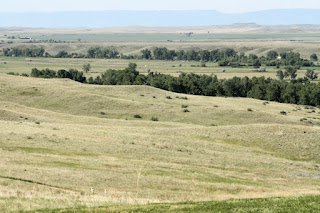We leave Montana today and head to Rapid City South Dakota following
I‑90 with stops at the Battle of Little Big Horn in Montana and Deadwood in
South Dakota.
The landscape has changed to more of rolling hills then the
stark spires of the mountains we have passed through the last several days.
The Battle of Little Big Horn is only about 50 miles outside
of Billings, Montana and we are there shortly before 9:00 AM.
Looking over the battlefield you can feel the sense of
defeat by the Calvary as you can see for miles, but only the tops of the little
hill crests. It is easy to see how the
Indians could sneak up to attack without even exposing themselves.
Lakota, Cheyenne, and Arapaho surrounded the approximately
41 men with Lt. Col. Custer on the hill when he ordered them to shoot their
horses to act as breastworks and fight to the death.
We spent some time looking over the hill with the markers
for the 7th Calvary where the slain troopers were found and
originally buried. The soldier’s remains
are not located here now, but reinterred to other cemeteries years ago.
Custer’s marker has a black background around the lettering
and is easily distinguished from the others.
On the other side of Last Stand Hill from the 7th
Calvary is the Indians memorial. The
Indian memorial was erected to honor the Native American participation in the
Battle of the Little Bighorn. Also, in
1991, Congress changed the name from Custer Battlefield National Monument to
Little Bighorn National Monument to commemorate all those who fought and died
here.
Reference to and names of Sioux,
Cheyenne, Arapaho, U.S, Crow Scouts, and U.S. Arikara Scouts who fought and
died during the battle are presented on plaques in a semi-circle opposite the
sculpture. It is difficult to name or
count the Indians that may have died, because they were returned to their camp.
Just beyond the Last Stand Hill and the memorials is a
National Cemetery. While looking at the
markers and taking pictures of the Cemetery, I found a marker for a Maine man
(Carmen and I lived in Maine) that died in 1875 and was in the 7th
infantry.
Before Carmen and I left Last Stand Hill where the markers
are for the 7th Calvary, we see a rabbit. Did I mention that we have seen many animals
on this trip so far?
We continued our trip and passed ranches with cows, horses,
sheep, llamas, and the occasional pronghorn antelope.
And of course deer, these were silhouetted nicely on the
hill top as we were driving by.
The country side has remained the same for most of the trip
today.
Passing grasslands and rolling hills spotted with trees.
We even pass an open coal mine where the stripped coal rides
on a conveyer belt to a processing plant on the opposite side of the highway.
About 33 miles from South Dakota, we pass near Devils
Tower. Now when I say near, I mean about
20 miles from I-90, on which we are driving.
Even so, we are able to take a picture, albeit, not a good one.
We make a short stop in Deadwood, South Dakota. Deadwood is where Wild Bill Hickok was shot and
killed in the Number 10 saloon while playing poker with his back to a door. Here is a reenactment of the incident. The people at the poker table are tourists
chosen for the parts.
Wild Bill Hickok, seen here,
wanted to sit in a seat that another player was already sitting and that
person said no. So he decided to sit in
the only seat available with his back to a door. He was holding a hand with two pairs, Aces
and eights, now known as the dead man’s hand in poker.
After arriving at our hotel, we pile back into the bus for a
trip for dinner and the evening program at Mt. Rushmore.
After the program, we headed back to the bus for the drive
back to the hotel.
Until tomorrow, Bob and Carmen.





















You are getting so much more from your tour guide. We went to many of these, but did not have the comments and information. Missed all that. Bummer. It is great to see it again.
ReplyDelete